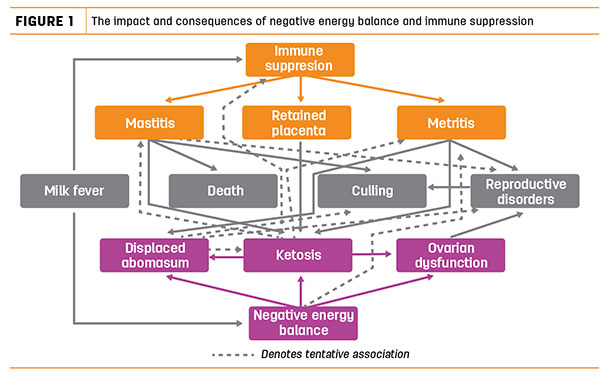It is estimated that out of every 100 calvings, about half of the cows will develop one or more fresh-cow problems, including displaced abomasum, ketosis, dystocia, retained placenta or others.
But there are things a dairy producer can do to reduce the risk of these costly diseases, starting with understanding why cows are so vulnerable during this time in the first place.
Why are transition cows at risk?
Elanco’s Dr. Andrew Holloway narrowed the causes of health problems in postfresh cows down to two issues: negative energy balance and immune suppression (Figure 1).
 “The cow is in a negative energy balance at this time,” he said. “This is normal in the early-lactation dairy cow.” Some cows are able to rebound from this state quickly while others struggle. These are the cows that develop problems like DA, ketosis and ovarian dysfunction.
“The cow is in a negative energy balance at this time,” he said. “This is normal in the early-lactation dairy cow.” Some cows are able to rebound from this state quickly while others struggle. These are the cows that develop problems like DA, ketosis and ovarian dysfunction.
Similarly, every cow naturally undergoes some degree of immune suppression around calving, due to high levels of estrogen and progesterone. Combined with other known immunosuppressants like stress, insufficient energy, low calcium levels and steroids associated with calving, these factors can lead to infectious diseases in the postfresh cow.
For example, immune suppression is associated with higher incidences of mastitis, metritis and retained placenta.
Ways to minimize transition cow risks
While we cannot change the cow’s innate responses from hormones and steroids, Holloway said there are a few things we can do to boost the chances of getting through the transition period without a major health incident.
-
Support proper calcium metabolism
Work with a nutritionist to have the cow’s mechanisms in place so it can absorb calcium and be sufficient in this vital mineral at calving. Low blood calcium is a cause for immune suppression.
-
Minimize dystocia
According to Holloway, difficult calving is the “number one variable associated with metritis.” For this reason, it is imperative to train employees on proper protocols for calving intervention.
-
Minimize dry matter intake decline prepartum
Studies show a direct correlation between reduced dry matter intake and higher incidences of metritis. Therefore, keeping cows eating is critical.
“The cows that do the best are the ones that eat their way through the dry period,” Holloway noted. “The ones that don’t drop dry matter intake before and after calving do a lot better.”
To encourage dry matter intake, he recommends reducing the amount of energy fed to far-off dry cows. Cows that are overfed energy don’t eat as much during the weeks leading up to or after calving; however, those that receive the correct amount of energy in the far-off stage eat better before and after calving. Work with a nutritionist to make sure nutrients are provided at proper levels, and consider alterative, lower-energy forages for dry cows.
Producers can monitor dry cow dry matter intake on a weekly basis by weighing feed refusals and noting major variations. It is important to keep an accurate cow count for this to be a useful benchmarking tool. Table 1 provides guidelines for dry matter intake for far-off and pre-fresh Holsteins and Jerseys. Cow comfort also promotes intakes. Holloway added, “Eating behavior is tied to lying behavior. If a cow is denied rest, it changes the way she eats.”
Cow comfort also promotes intakes. Holloway added, “Eating behavior is tied to lying behavior. If a cow is denied rest, it changes the way she eats.”
-
Maximize the return to high dry matter intake postpartum
High feed intakes among fresh cows are a function of providing an environment that meets the cows’ needs: access to consistent high-quality feed, reducing stress and providing a comfortable place for cows to rest.
Holloway pointed out that cows usually spend 12 to 14 hours a day lying down – or even more for high producers. They should not have to fight for stall space or be left with standing room only because pens are overstocked.
Ample space for eating, resting and drinking make the cow more apt to consume higher levels of dry matter, reducing the risk of many fresh cow diseases.
Dr. Andrew Holloway presented this information during the 2017 Land O’Lakes Leading Dairy Producers Conference held Jan. 5-6, in Wisconsin Dells, Wisconsin.

-
Peggy Coffeen
- Editor
- Progressive Dairyman
- Email Peggy Coffeen






